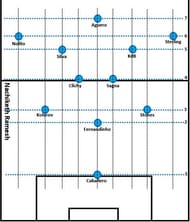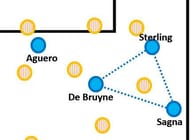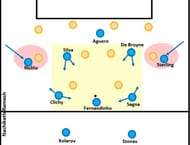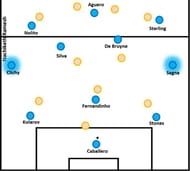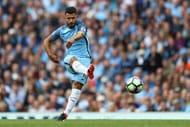Pep Guardiola began his tenure at Manchester City with a hard earned 2-1 win over David Moyes’ Sunderland. In his first official game in England, Guardiola’s side displayed flexible attacking with width utilization, effective possession with improved positional play compared to City’s pre-season friendlies, dynamic positioning with inverted fullbacks.
The home side earned the lead through Sergio Aguero’s penalty and later through Paddy McNair’s own goal after Jermain Defoe had equalized for the visiting side.
Teams:
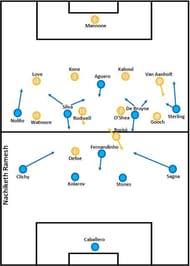
Manchester City: Willy Caballero; Gael Clichy, Aleksandar Kolarov, John Stones, Bacary Sagna; Fernandinho; Nolito, David Silva, Kein de Bruyne, Raheem Sterling; Sergio Aguero.
Sunderland: Vito Mannone; Patrick van Aanholt, Younes Kaboul, Lamine Kone, Donald Love; Lynden Gooch, John O’Shea, Jack Rodwell, Duncan Watmore; Fabio Borini, Jermain Defoe.
Guardiola started with a 4-1-4-1 formation and Moyes preferred 4-4-2.
Clichy and Sagna as inverted fullbacks
Guardiola had used his full-backs in a similar role in the friendly game against Arsenal a week ago. Against Sunderland, he chose to use Clichy and Sagna more in the central region that in the wings, effectively converting them into inverted fullbacks.
The reason behind this is mainly because of the inclusion of Silva and De Bruyne in the attacking midfield. Although the starting shape looked more like a 4-3-3 with Silva and De Bruyne playing as central midfielders or #8s, City was playing in a 4-1-4-1 with the above mentioned attacking players in #10 or central attacking midfield role.
This left Fernandinho alone in the central midfield region – prone to counter attacks from Sunderland, should City’s counter-pressing fail.
Also since Fernandinho was dropping between Stones and Kolarov - the center backs - during the build-up phase, City needed players in the central regions to facilitate ball progression through the middle and to circulate it well.
If Guardiola had decided not to use Clichy and Sagna as inverted fullbacks then while Fernandinho was dropping deep, Silva and De Bruyne should’ve dropped deeper as well.
In such a situation, in order to provide presence in the half-spaces and offer depth, Sterling and Nolito could’ve cut in from wide positions. But this would’ve made Manchester City’s attacking very predictable.
The movements of Gooch and Watmore, Sunderland’s wide midfielders, were dependent on the positioning and movements of City’s wingbacks. Gooch and Watmore were taking narrow positions when Clichy and Sagna were playing centrally.
This was freeing up City wingers, Nolito and Sterling and enabling them to take on the opponents in 1v1 situations.
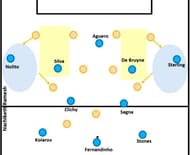
With inverted fullbacks, City players were occupying both depth and width in a manner most suited for ball progression and circulation. With inverted fullbacks and two #10s, City was changing from 4-1-4-1 to something close 3-2-2-2 formation.
With this, Manchester City players were occupying depth in 7 horizontal lines and width in 9 vertical lines.
As Louis van Gaal puts it “I want 8 lines...8 lines...so many as possible... because then the occupation of the pitch it's better,” pitch can be better occupied.
Here better means, the players can position themselves in such a way that they can create rhombuses or triangles between themselves, allowing them to beat the press of the opponents easily and move the ball towards the goal.
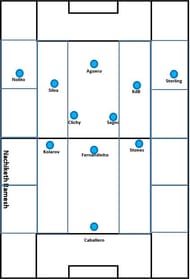
Silva and De Bruyne in attacking midfield – Key to ball progression
What was very interesting about Guardiola’s line-up yesterday was his preparedness to face a low block defense from Sunderland. Although Sunderland didn’t exactly sit very deep, they had a tight shape in front of the box.
With Silva and De Bruyne starting as #10s, Guardiola was able to move them a little bit wide and occupy the half-spaces. This was providing an excellent connection between Silva / De Bruyne and the players around them. If Sunderland decided to press the players in the half-space, then they were at the risk of opening space somewhere else.
Most of the time, due to good structure in possession, Silva and De Bruyne had at least one safe passing option.
Also, half-space to half-space ball switches were possible and gaps in the defensive block was being created as a result of this.
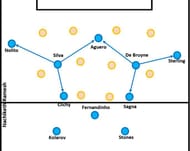
Triangles to beat pressing on the wings
Since a player with the ball on the wings will be restricted to only 180 degrees to move, it is relatively easy to setup pressing traps and execute them in the wings. Sunderland, too, had plans to press, win the ball back and counter-attack through the wings.
But since Manchester City players close to the winger were forming triangles, it became tough for Sunderland to press. Thus with good passing structures, City collectively achieved pressing resistance.
In general, City had the aim of getting players behind the line of pressure. We saw that City played with seven lines and it was very easy for them to beat pressing with such a staggered structure.
City’s shape in possession good enough to prevent Sunderland’s counter attacks
City started with a 4-1-4-1 formation. In the build-up phase, it was changing to 3-2-2-3-ish shape. After the build-up phase, when the ball was in the middle third City was changing to a 2-3-2-3 shape with Fernandinho moving into the space between Clichy and Sagna. This had two advantages from City’s perspective.
- Manchester City had five players in the center and half-spaces in the middle third against Sunderland’s four. This overload enabled City to dominate the possession, which we saw that City had 77% of the ball possession against Sunderland, and circulate well in order to patiently create openings. Also, note how well prepared City is to prevent counter attacks through the center.
- City had four players one the left side of the field and four the right. Three were in the middle. The four on the sides were always joined by Fernandinho whenever the ball was lost. So City was able to overload the zone where the ball was lost and try to regain possession quickly in the wide regions.
City build-up game
One of the main things expected from Guardiola’s side was the attack initiation through Salida Lavolpiana method – in which the ball is brought out from the back with the goalkeeper as the initial point and numerical superiority is achieved.
City’s center backs were split by Fernandinho to make a chain of three in front of Caballero.
This provided a 3v2 or 4v2 including the goalkeeper in favor of City. With smooth ball progression from the defensive third, City was able to carry out the numerical advantage over to other zones at micro (1v0 or 2v1) and sometimes at macro level (5v4).
Fernandinho, dropping deep, was forming a rhombus with one of the inverted full back. This was forcing Sunderland to press high with large numbers, which was only allowing City some breathing space higher-up the pitch.
Aguero as False 9
Aguero played as false 9 and was regularly getting involved in the attack by dropping into the middle third. The gap left by Aguero was filled by either one of Silva or De Bruyne or by a winger cutting in from wide.
In the inward movement of the wingers, there was a peculiarity. Nolito, during his time on the pitch, drifted towards the center only a few times – probably two. He was mainly sticking to the wings. Whereas on the other side, Sterling and Sagna were regularly swapping between wings and half-space.
When De Bruyne was moving further central from his half-space position, Sterling was moving to half-space to create an overload on the back line and Sagna was drifting out wide to the wings.
After Clichy’s substitution
When Clichy was substituted and Kalechi Iheanacho was brought in his place, City moved to a proper and permanent back three of Kolarov – Stones – Sagna with Fernandinho just ahead of them.
The shape was a 3-1-4-2. Even before this substitution, City was changing to back three and was overloading the front line with five players in a 3-1-5-1 shape.
What did we learn from the game?
Manchester City’s performance against Sunderland, in contrast to its pre-season games, was a massive improvement. Caballero committed a few mistakes but was not as error prone as he was in the previous games. However, between him and Joe Hart, Guardiola doesn’t have a goalkeeper suitable for his playing style.
Manchester City should be entering the market for a goalkeeper who is a good passer of the ball and has the ability to play under pressure.
City displayed pressing resistance by placing players behind the line of press, played with exploiting width to stretch the defence and depth to open gaps between the lines, showed great flexibility and positional dynamism.
They also had a good understanding of positioning between the players and was quite comfortable in bringing the ball out of defence – all of which are tools required to play positional play of a high degree.
The future seems to be good but it is not correct to rate a team based on only one performance. However, in such a short time Guardiola has converted City from a typical English team, to play his style of football which features a lot of effective possession.
Watch this space for the analysis of Manchester City’s Champions League qualifying game against Steaua Bucuresti.
